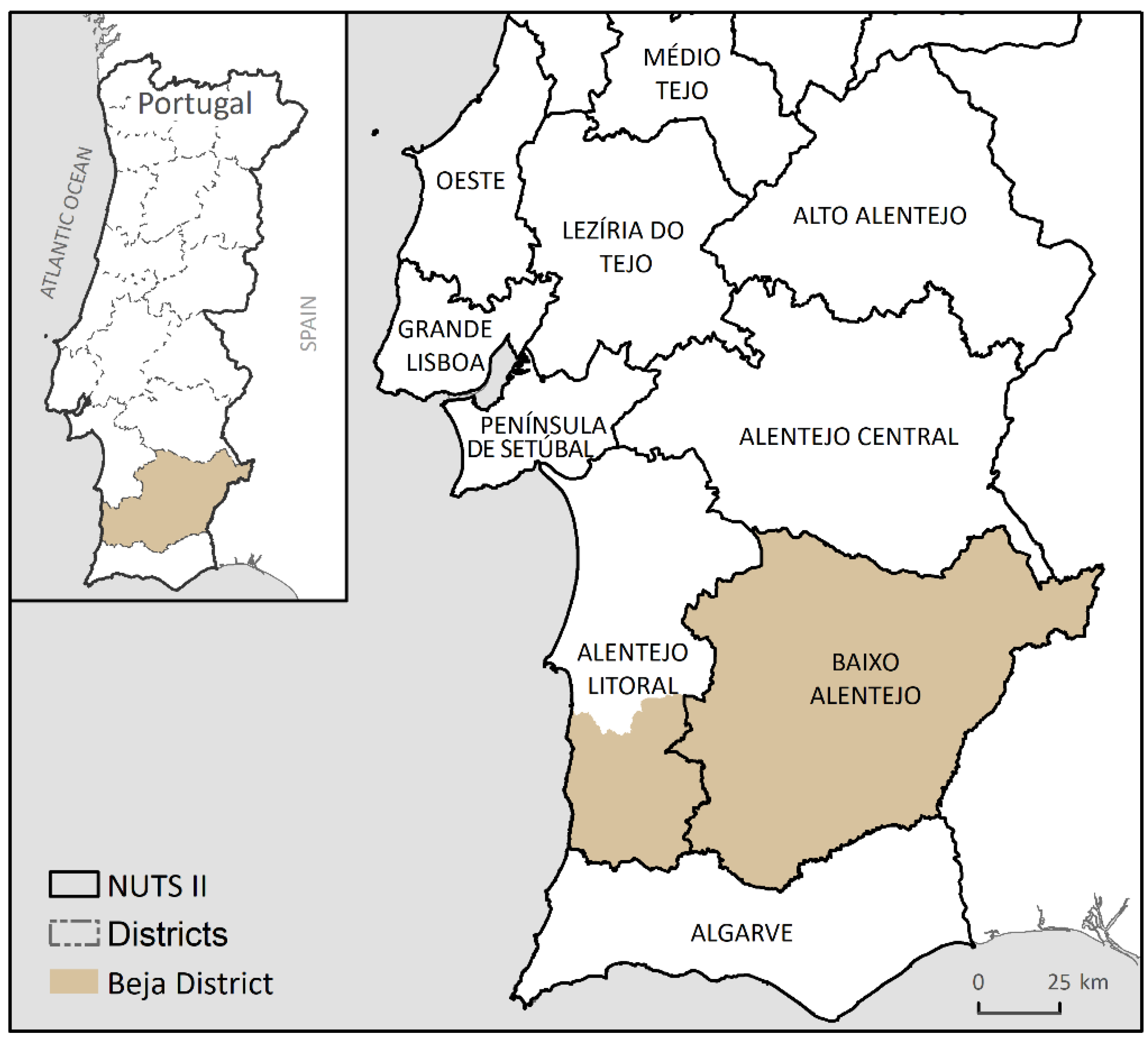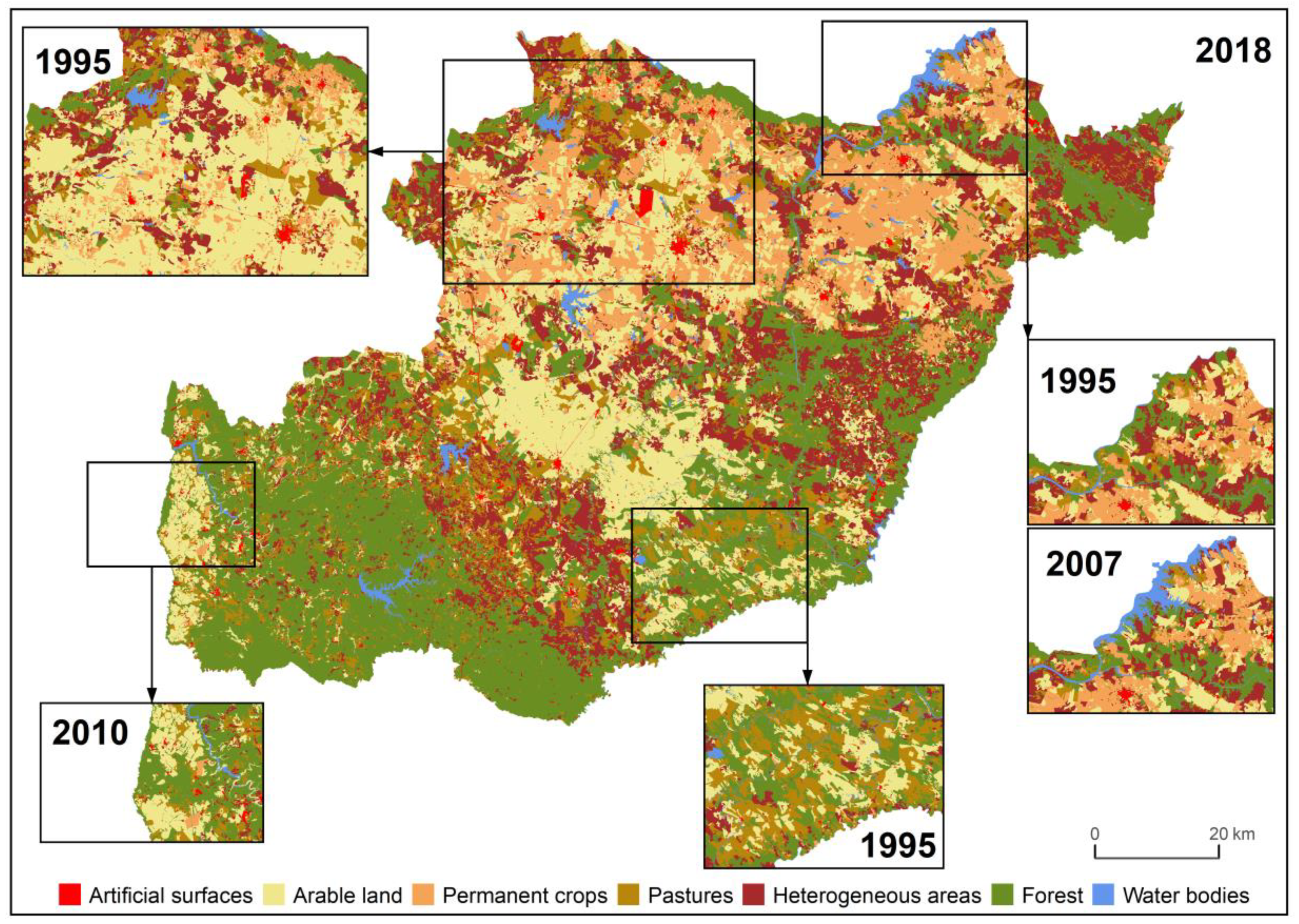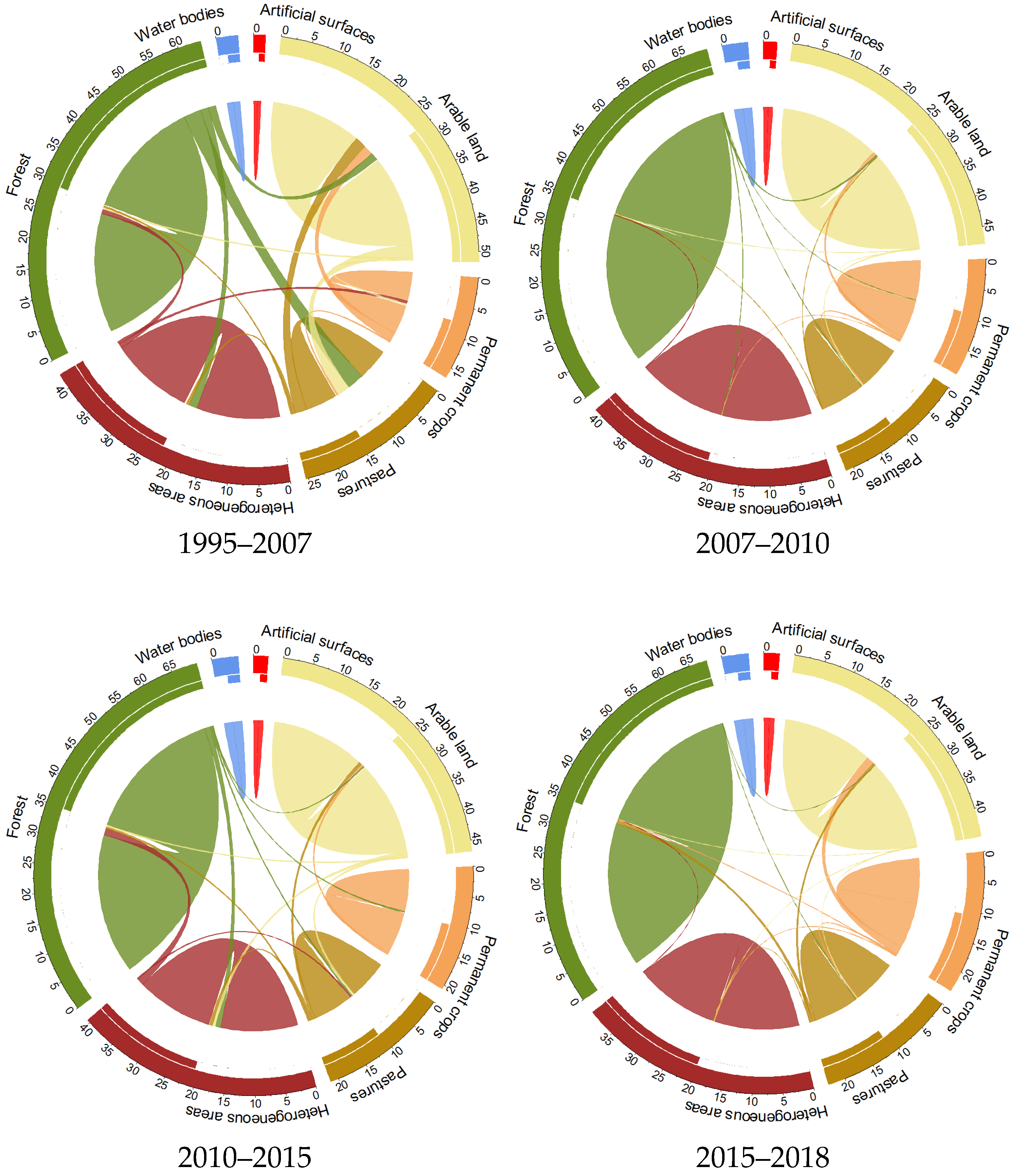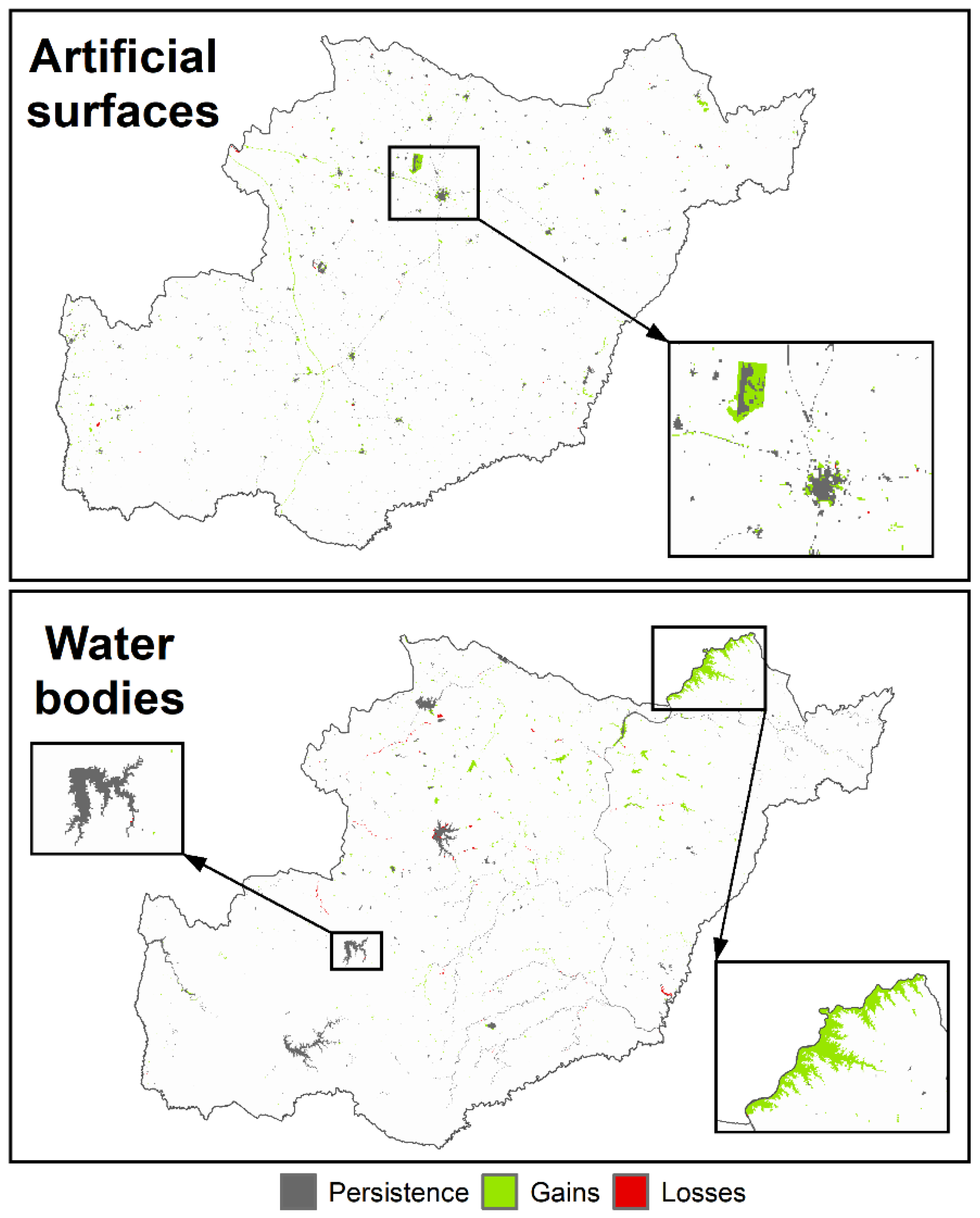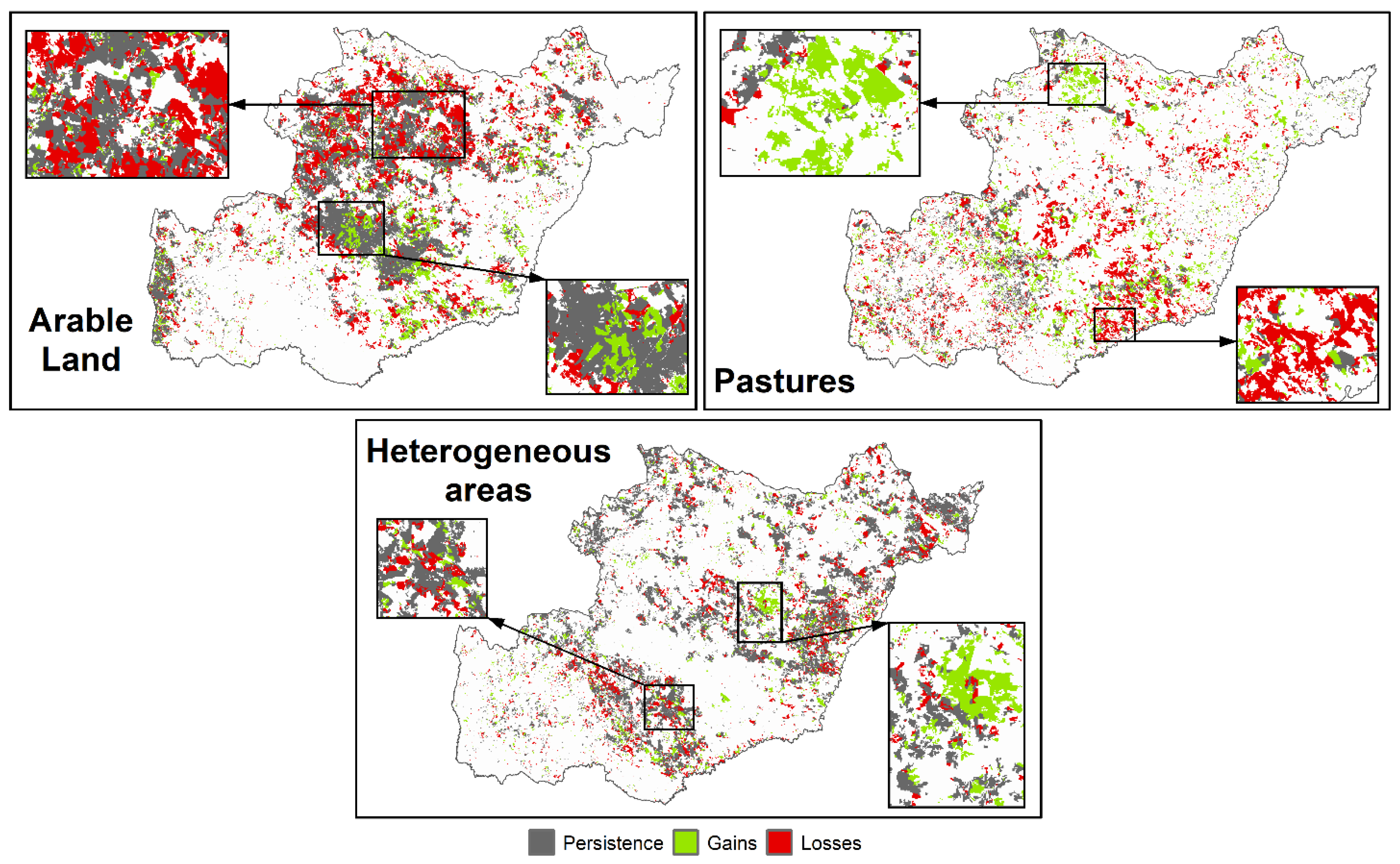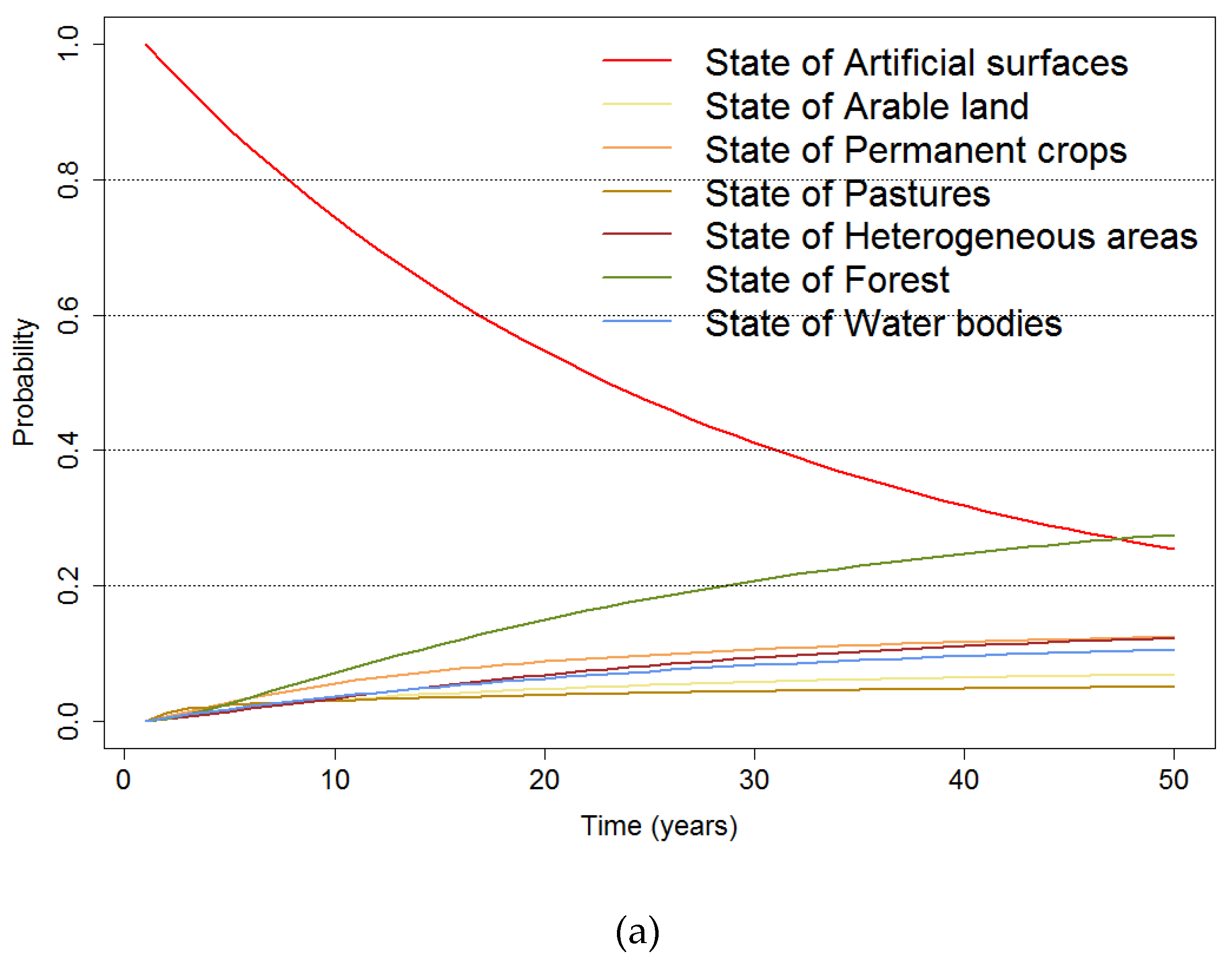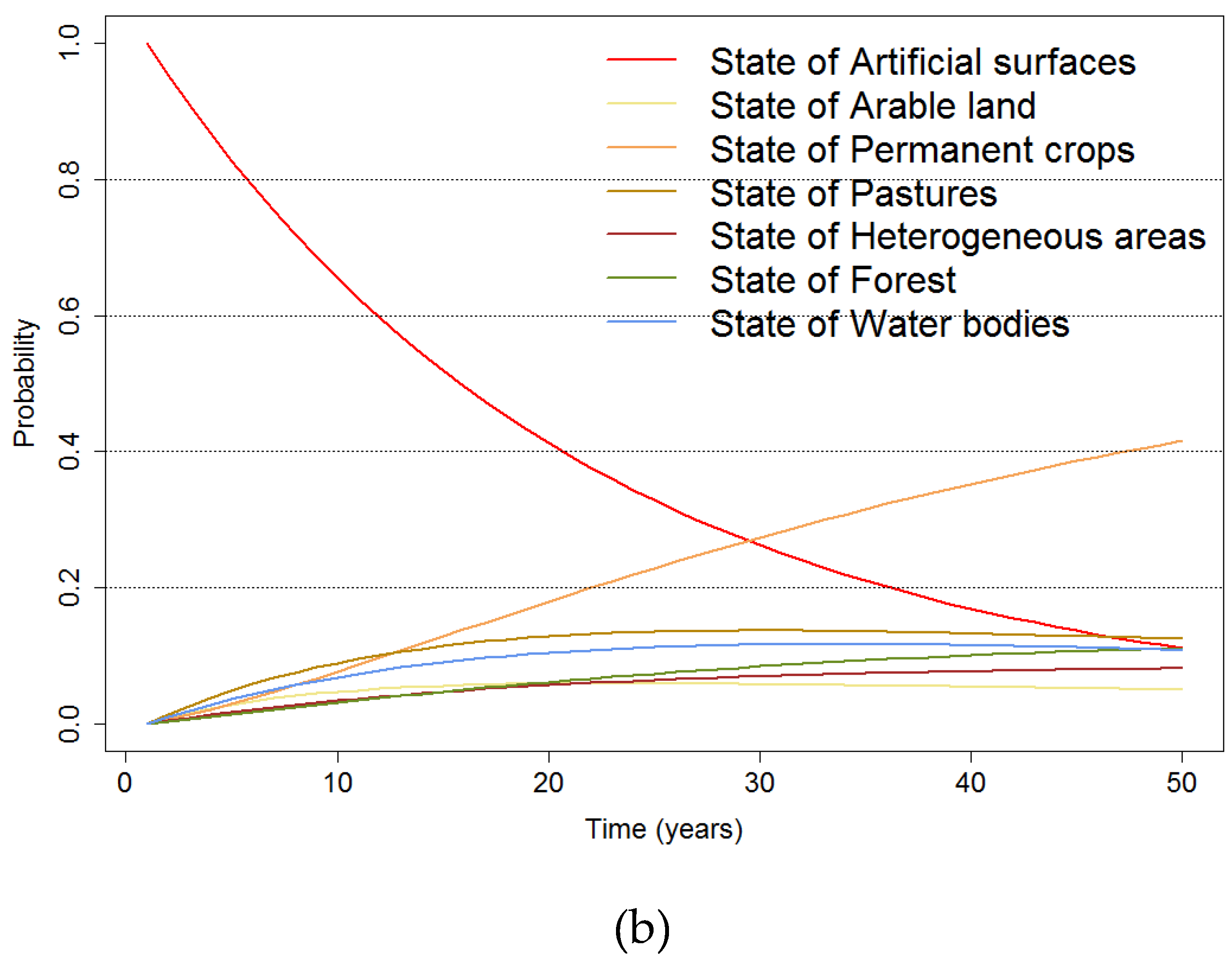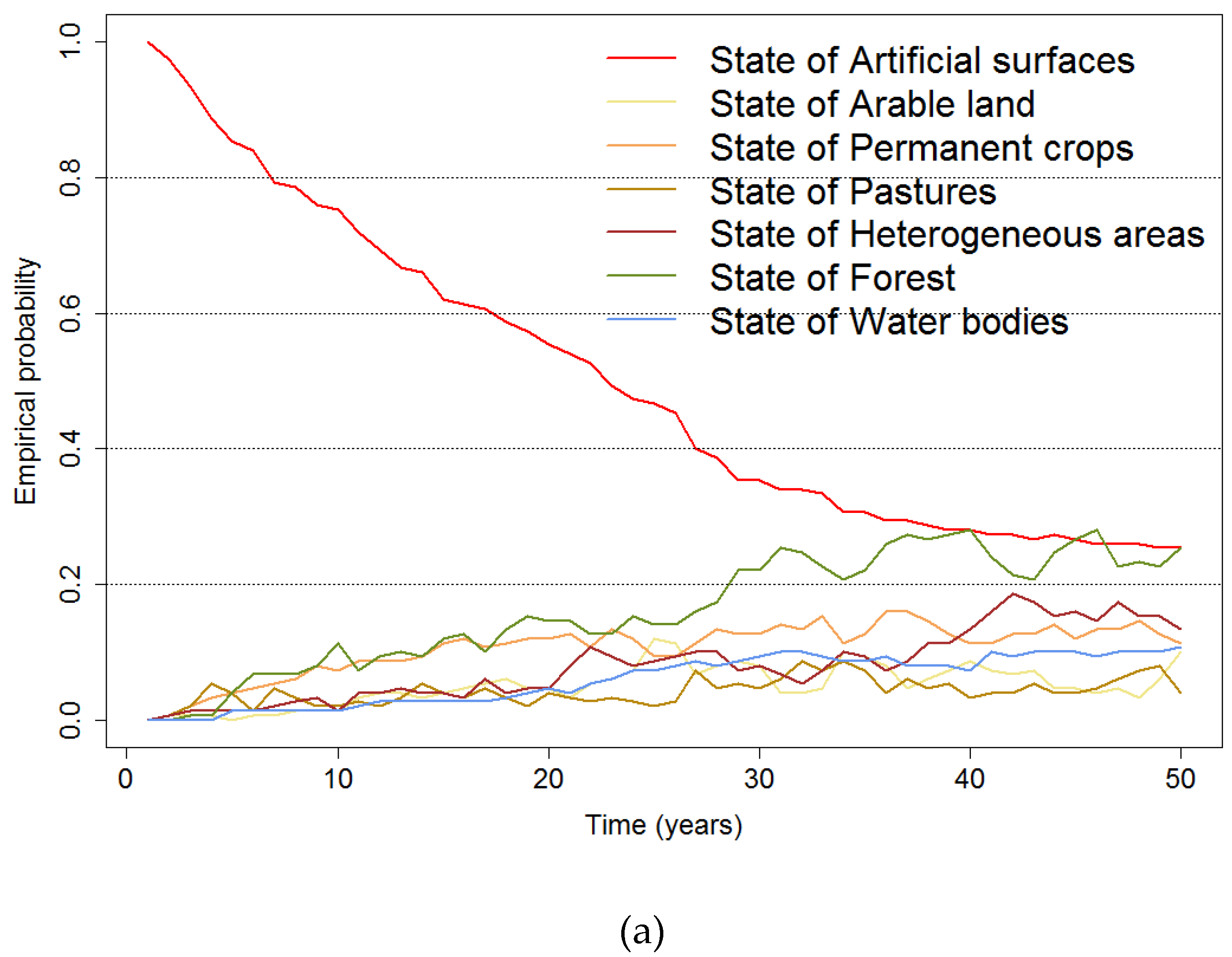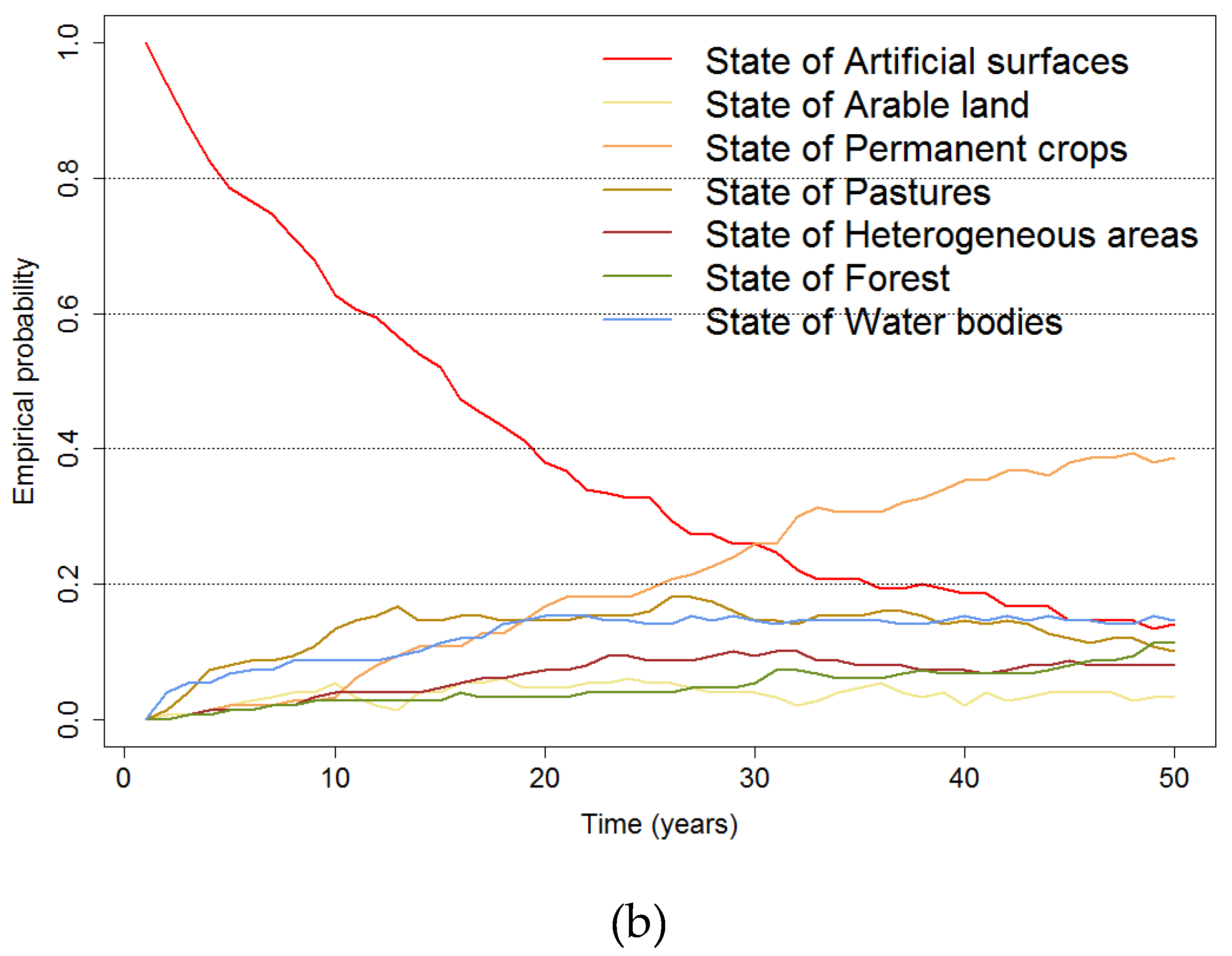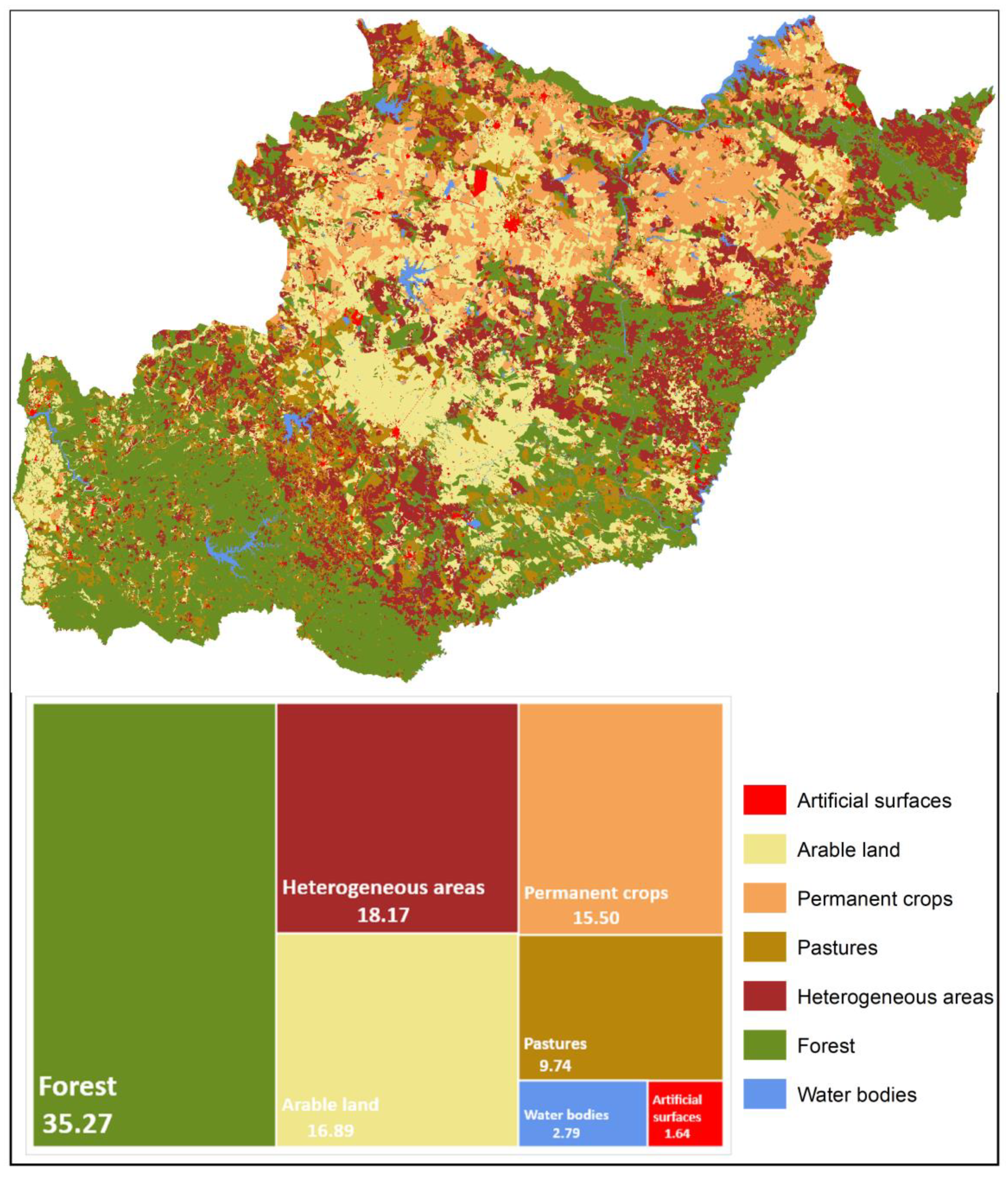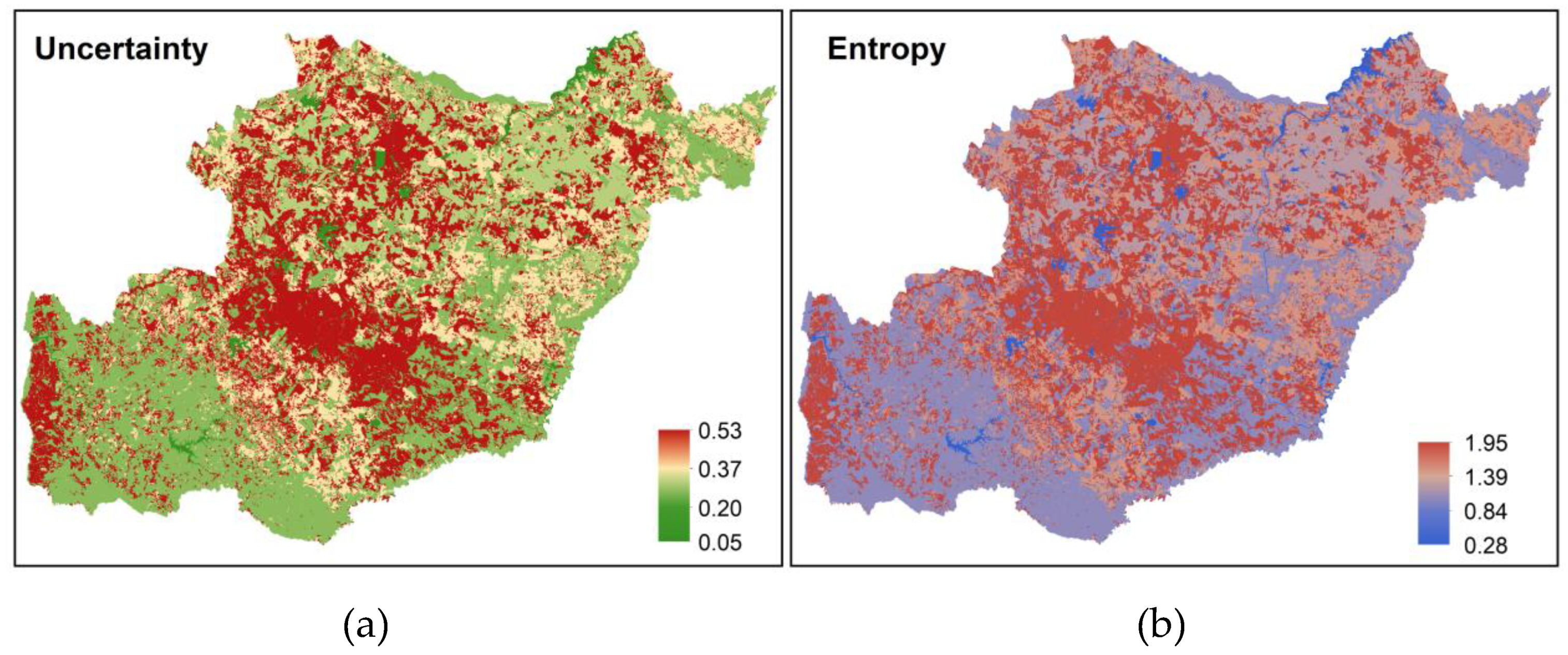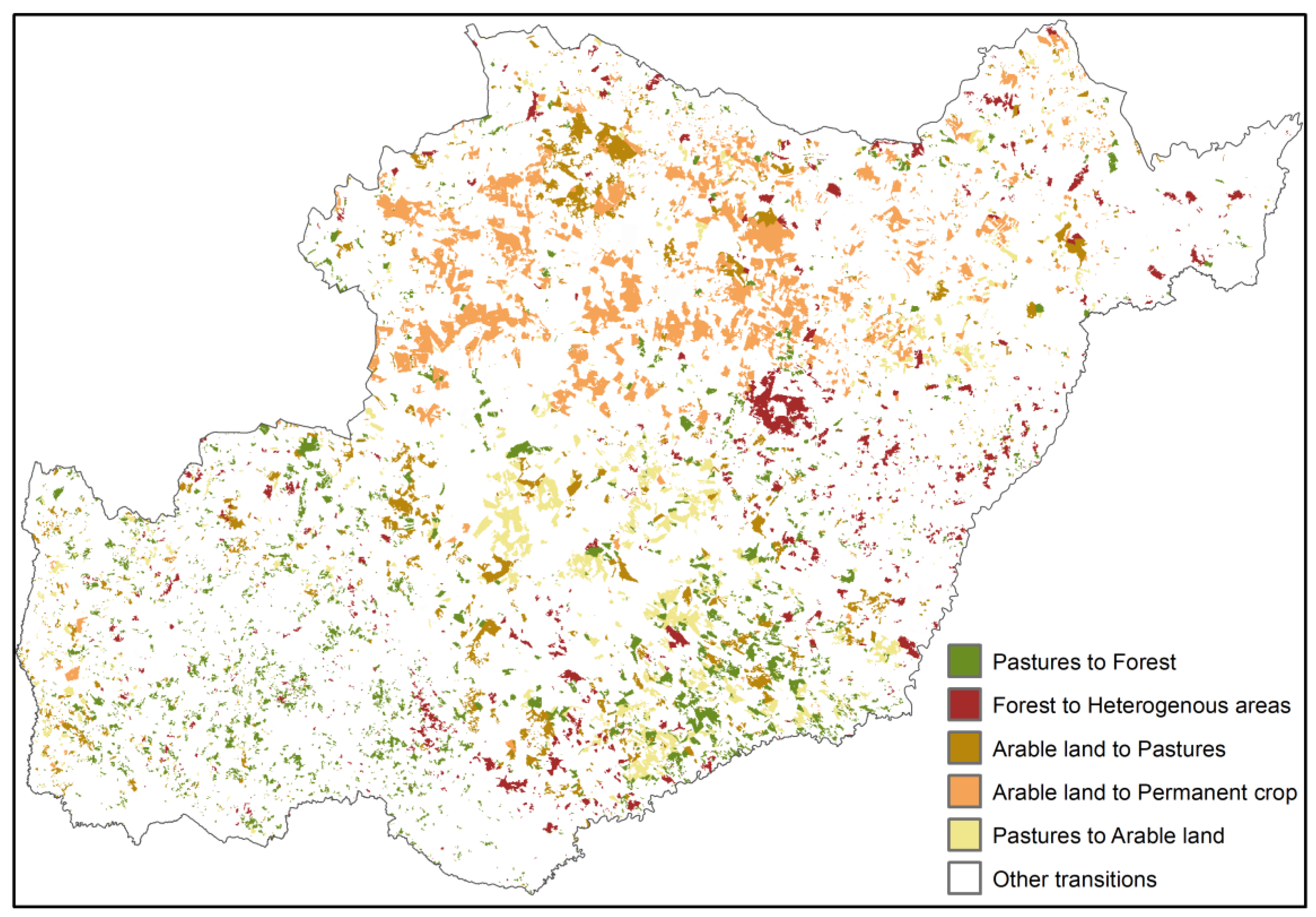In recent decades, the abandonment of agricultural land has been an international trend. In Portugal, this has occurred, confirming marked changes in the agricultural landscape [
30,
31]. Therefore, in this study, we analyzed the spatiotemporal changes that occurred in the largest district of Portugal, Beja, which has an agricultural economic background, and provided a trend projection for the year of 2040. Accordingly, the monitoring of the dynamics of LULC at the regional level revealed noteworthy LULC dynamics intrinsically associated with distinct agricultural practices of food production and distribution.
4.1. About the LULC Changes Detection
The degree of transition between the LULC classes in the Beja district was significantly different during each period under analysis. The following findings are worth noting:
- (i)
In 23 years, about 28% of the Beja district experienced dozens of inter-class transitions, but the most significant changes were in the croplands. Nevertheless, croplands remain the predominant LULC class in more than half of the Beja district (in 2018 about 64%). Particularly, there was a predominance of arable land that was dispersed in a great part of Beja, despite the significant decrease in this practice between 1995 and 2018 (−5.9%). Despite the decrease, the results confirmed the importance of cereal production in this region, as in the case of wheat [
43,
44]. Likewise, heterogeneous areas experienced a continuous decline (−2%), but even so this class represents the second largest cropland in the district, which confirms the relevance of the Montado system and the cork oak exploitation in the agroforestry areas of the district.
- (ii)
Of all the agricultural classes, permanent crops experienced a growing tendency. Thus, this cropland gained prevalence after a certain period and simultaneously experienced some loss (+5.13% between 1995 and 2018). In spite of the reduction in the territory, the substantial increase in permanent crops suggests an emphasis on intensive farming without fallow, proved by the enlargement of the olive grove plantation in this region and the increase in olive oil production [
43,
44]. These results are consistent with other studies, despite the methodological approach differences [
31,
32,
45].
- (iii)
As for the overall period, forests experienced more gains than losses (+4.31% between 1995 and 2018). There was a clear tendency of agricultural land loss to the detriment of forests, these results being in line with what is happening on a national level observed in other studies [
30,
46]. Additionally, about 63% of the total changes experienced by forests was attributed to a swap type, which may indicate that the Beja district simultaneously experienced forms of reforestation and deforestation between 1995 and 2018.
- (iv)
Lastly, artificial surfaces and water bodies experienced more gains than losses and showed a tendency to persist. A main cause for these observed gains is spatial conversions, such as the expansion of the Beja airport area and the construction of new roads in the case of artificial surfaces [
47], and the Alqueva dam construction in 2002 in the case of the water bodies [
31]. Nonetheless, artificial surfaces only increased about 0.45%, between 1995 and 2018, which indicates that the increase in urban areas was not remarkable in the Beja district, thereby counteracting the Portuguese trend towards an urban area increase [
46].
Accordingly, the behavior of the inter-class transitions was significantly different between periods, and explicitly revealed that arable land, pastures, and forest were the most dynamic LULC classes, having experienced both damage and recovery over the years. Hence, the drivers that promote the LULC gains are likely to differ from the drivers that lead to LULC losses [
12]. On the one hand, the main cause for cropland changes could be the competition between LULC classes, since such competition may restrict the use of available land even when this land has suitable determinants for a specific LULC class, which would explain higher observed losses compared with gains [
12]. In addition, the political measures of incentives for the increase in technology, for example, the almost total abandonment of traditional agriculture or the high level of subsidies to agriculture, could be explanatory factors for the agricultural LULC changes observed [
48]. Accordingly, the LULC periodical fluctuations were depolarized by certain drivers, such as political decisions, economic development planning, or even weather conditions, showing the importance of the analysis of the possible drivers of changes in future work [
46].
4.2. About the Dominant LULC Transitions
The analysis of the differences between the observed LULC and the expected LULC gains and losses under a random process of changes showed that, of the several observed inter-class transitions, few experienced dominant signals of change between 1995 and 2018 (
Figure 11), namely:
- (i)
transitions of arable land to permanent crops and to pastures, which accounted for about 5% and 2.9%, respectively;
- (ii)
transitions of pastures to forest and arable land, which accounted for about 3.5% and 2.7%, respectively;
- (iii)
transitions of forest to heterogeneous areas, which accounted for about 2.1%.
Accordingly, the arable land tendency to lose, especially for the permanent crops class, causes some concerns. The Beja district located in the Mediterranean region is a suitable region to produce olive oil mainly due to favorable weather conditions. Moreover, the positive market environment prevailed with the gradual increase in global olive oil consumption in the past decade, and the super-intensive olive grove plantation also increased to cover the demand [
45]. Thus, traditional olive grove plantations are becoming unusual, mainly because the super-intensive cropland production profitability is higher and because of Common Agricultural Policy (CAP) incentives [
49]. While this type of agricultural practice will start producing in the 3rd year after planting, the traditional practice can occur after one decade. In addition, mechanization in the super-intensive olive grove is less labor-dependent, meaning a greater capacity for profit. Hence, this all points to one conclusion: the high increase in super-intensive olive crops to produce olive oil is highly associated with the expansion of permanent crops, which is at the expense of arable land.
Thus, the Beja district is experiencing a new landscape dynamic, caused not only by the systematic increase in permanent crops areas but also by the decrease of arable land that produces a historical agricultural product: wheat (the grain of civilization). Indeed, over the last century, Beja consistently showed remarkable importance in wheat production, mainly explained by: (i) the type of soil in Beja, “Barros de Beja” (Beja clays), which is a dense and deep soil that is particularly suitable for this cereal production; (ii) the type of land exploitation (latifundium) [
50]; and (iii) the weather conditions (i.e., a temperate climate with Mediterranean characteristics), as the wheat crop has a relative tolerance to water deficiency [
51].
Thus, these results indicate that, although arable land predominated in the Beja district between 1995 and 2018, this cropland experienced a significant decrease due to the competition between LULC classes. Accordingly, the transition from arable land to permanent crops was relatively constant over time, and it was more pronounced in the last period (2015–2018), presumably triggered by the substantial increase of foreign investment (especially from Spanish investors) and the strong exploitation of water resources, after the construction of the Alqueva dam that filled its reservoir only 10 years after construction began (in 2012) [
45]. Thus, it seems essential to assess the impact of this systematic transition, since everything points to an increasing super-intensive olive grove cultivation system that will result in a negative impact on this land in the future [
52].
In addition, arable land also experienced systematic transitions to pastures. This change was especially strong in the first period (1995–2007), possibly due to changes in the CAP, which led to a decrease in the areas under arable crops, in particular cereal production, and an increase in fallow land maintenance and natural pasture. These policies arose out of a concern related to land preservation in the context of rural planning, resulting, among other actions, in reduced dryland cereal cultivation areas, due to the recognition of the negative impact on soil depletion and erosion resulting from previous agricultural campaigns [
53] and an international acknowledgement of the role of such areas in mitigating climate change [
54,
55].
On the contrary, Beja also experienced a systematic transition from pastures to arable land. This dynamic LULC change was substantially stronger in the first period (1995–2007) and partly contradicts the prior interpretation of the possible factors responsible for such changes. Therefore, following the abovementioned explanations, we believe this transition can also be linked with the implementation of the CAP, which favors fallow land maintenance. Indeed, the arable land class mainly comprises a land rotation system between annually harvested crops (rain-fed or irrigated) and fallow plots, which in our study area mainly represents dry-fed and rain-fed cereal production. However, according to the COS map nomenclature, this class can also comprise fallow land for a maximum of five years. Additionally, agricultural pasture systems have limitations regarding their production irregularity over a given year due to the irregularity of rainfall [
56,
57] and may not be economically viable for farmers if not subsidized [
50,
58], which may partly justify these changes in the landscape.
In the Beja district, a systematic transition from pastures to forestland was also found, and this was most significant in the first period (1995–2007) and was probably associated with afforestation policy (the 1992 CAP reform) and EU subsidies (Agenda 2000), which promoted the conversion of pastures in Eucalyptus and
Pinus forests [
50] for conservation of the land’s structure and functions. Lastly, the systematic transition from forest to heterogeneous areas, which occurred significantly between the third period (2010–2015), is probably related to forest fires, as reforestation took place after this event in the form of
Montado to combat desertification [
59].
For instance, the examination of the systematic and random transition showed that some of the major LULC transitions, such as heterogeneous areas and arable land transitioning to forest (2.53% and 1.78%, respectively) and the heterogeneous areas transitioning to pastures (1.18%), were random or partially systematic. In addition, it is interesting that heterogeneous areas did not experience systematic losses, which indicates a strong signal of persistence in this LULC class. Thus, the Beja district still retains important traditional agricultural areas, such as the Montado, an agrosilvopastoral system of global importance.
4.3. About the LULC Future Changes
The transition probability simulation between uses for the year 2040 allowed us to understand that imbalances can arise in the future, highlighting that about 25% of the territory is predicted to transition, and about 21% of that territory corresponds to agricultural land. These results are a warning that the Beja district will experience strong landscape dynamics in agricultural land, emphasizing the importance of measures in mitigating the negative effects of such strong signals of LULC transitions [
12].
Additionally, the DTMC model showed a high agreement value, proving to be a useful mechanism for monitoring and evaluating LULC changes, with a trend projection with high applicability and flexibility. Therefore, the main advantage of using Markov chains is their mathematical logic that enables swift applications, as well as their possible interaction with other techniques such as remote sensing and GIS, both of which commonly work with matrices. However, a disadvantage of this model is that it does not explain the facts, because the process only takes into account the time variable. Thus, predictions made through this model mostly indicate changes in the state of variables in time and not in space. Nevertheless, the stationary probabilities are useful as indicators of the landscape shares of each LULC class and provide highly valuable information in decision-making processes.
4.4. Main Conclusions and Future Studies
The purpose of this study was to analyze the spatiotemporal evolution of LULC in Beja from 1995 to 2018 and simulate the future development for the year 2040. This analysis indicates that in 23 years there were significant changes that deeply modify the Beja district landscape, mainly due to two opposite phenomena: the intensification of agricultural practices and the afforestation of agricultural lands. The observed LULC patterns reflect the last decade’s structural changes in the Portuguese economy and society and confirm the impact of political decisions and different agricultural activity management, which led to the loss of a significant amount of agricultural heritage. In fact, this regional landscape and the traditional features of agricultural land are facing an uneven transformation dynamic that does not take into account either the balance or the environmental enhancement of the local diversity agricultural systems [
49].
The acquired spatiotemporal knowledge regarding the agricultural LULC changes allowed us to obtain a general picture of the main transitions of a region of Portugal that has more importance in the regional agricultural production sector, particularly in the production of cereals, such as wheat, barley, oats, and other products such as olive oil and cork. An understanding of the systematic transitions and the locations thereof provides useful insight into ecosystem service management and contributes to future sustainability strategies. Nonetheless, this statistical approach is exclusively based on an analysis of the LULC transition matrix, and the interpretation of the LULC transitions is based on a sequence of historical determinism documented in prior investigations (e.g., [
49,
57,
60]), so any factor mentioned to rationalize the systematic transition is based only on assumptions of historical fact. Therefore, additional research is necessary to assess the many processes that create these LULC changes, which have been linked to dozens of possible drivers and their different levels of feedback. Still, providing an understanding of the inter-class transitions that have occurred as systematic changes has proven to be a straightforward, effective approach that allows us to differentiate the predominating quantity transitions from those that experienced a single abrupt episode process of change influenced by factors that occur suddenly.
The information obtained contributed to sciences related to the earth and human society on a variety of levels, providing effective information for economic and environmental monitoring and evaluation, resulting in informed policy decisions and in the design of anticipatory measures response to change. Furthermore, in this exploratory study, we used COS maps, official Portuguese LULC data produced by a governmental institution (DGT), and these data were advantageous because of their higher cartographic detail and were characterized by temporal continuity. This highlights the importance of having an entity responsible for producing LULC thematic cartography with regularity and reliability and making it available free of charge, as it can be used for multiple purposes, such as territorial planning and management, ecosystem service mapping, and the identification of areas vulnerable to rural fires (e.g., [
34,
61,
62,
63]).
